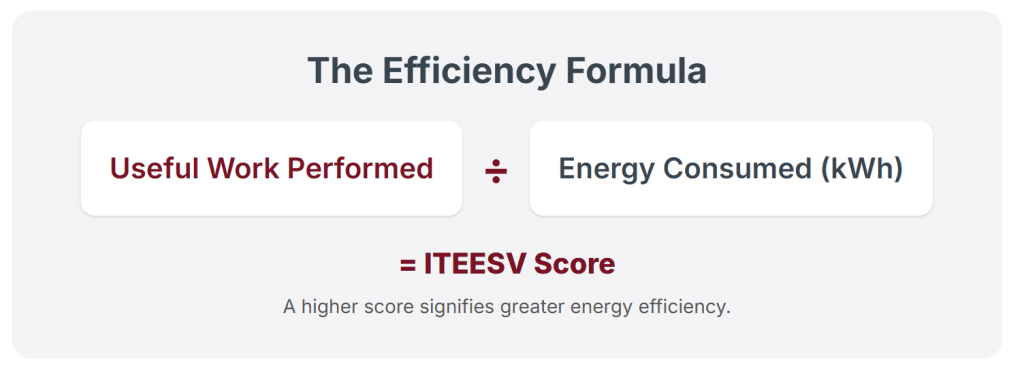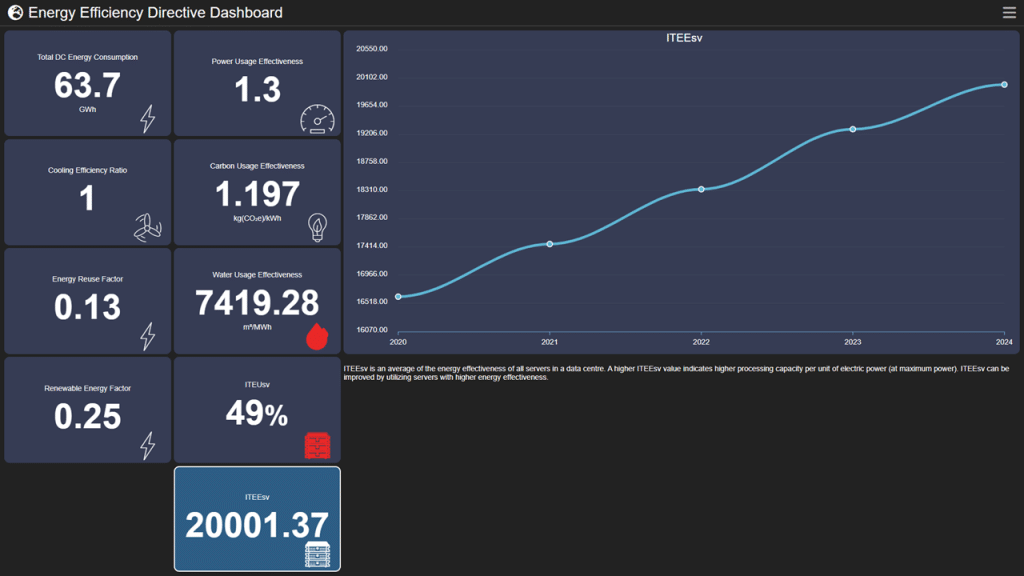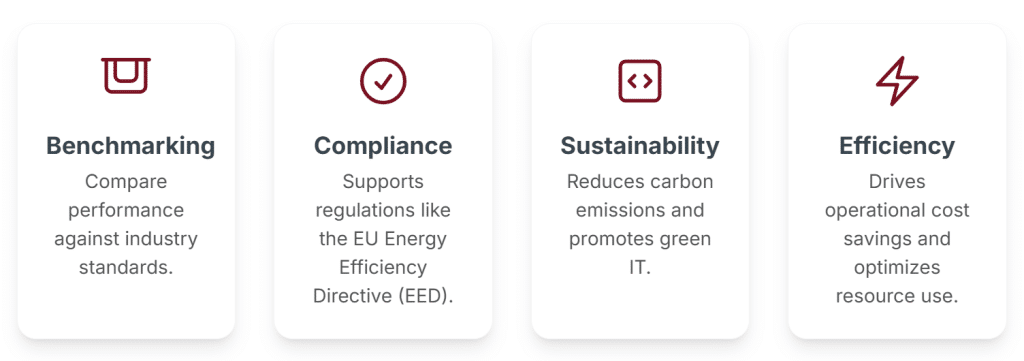The Value of ITEEsv in Sustainable Data Centers
Published on February 21, 2024,
by
As data centers face growing demands and environmental scrutiny, the server energy efficiency metric, known as ITEEsv, has become a vital tool for sustainable operations. By measuring the performance output of servers relative to their energy consumption, ITEEsv empowers operators to optimize infrastructure, reduce costs, and align with global sustainability standards.
Understanding ITEEsv
ITEEsv stands for IT Energy Efficiency of Servers and is a key performance indicator (KPI) that assesses the energy efficiency of servers in data centers. Defined by the ISO standard IEC 30134-4, ITEEsv calculates the maximum performance servers can achieve per kilowatt of energy consumed, focusing on potential rather than actual operational performance. This metric is vital since servers significantly contribute to a data center's overall energy use.

Illustrative Calculation

Consider a server that processes 10,000 tasks per hour and consumes 500 kW. The ITEEsv is calculated as the number of tasks performed divided by energy consumption, yielding an ITEEsv of 20 tasks per kW. This figure helps data center operators understand how efficiently servers use energy, guiding decisions to optimize performance and reduce consumption.
- Server Performance: The server can handle 10,000 tasks per hour.
- Energy Consumption: The server consumes 500 kW of power per hour.
The IT Energy Efficiency of Servers (ITEEsv) can be calculated using the formula:
ITEEsv = Number of Tasks Performed ÷ Energy Consumed (in kW)
Plugging in the values from our example:
ITEEsv = 10,000 tasks ÷ 500 kW
ITEEsv = 20 tasks per kW
Interpretation
An ITEEsv of 20 tasks per kW indicates that for every kW of power consumed, the server can perform 20 tasks. This metric helps assess the server's energy efficiency, allowing data center operators to make informed decisions about optimizing server performance and reducing energy consumption for a more sustainable operation.
IT Energy Efficiency of Servers (ITEEsv) stands out as a critical measure, focusing exclusively on the efficiency of physical servers. Unlike metrics that might consider virtual servers, ITEEsv zeroes in on the tangible hardware that powers our digital world. This precision allows for a more accurate assessment of a data center's environmental footprint and operational efficiency.
Example Application in Sustainability Dashboarding

Nlyte Software's Sustainability Compliance Reporting Dashboard - IT Energy Efficiency of Servers (ITEEsv)
Understanding ITEEsv's Core Principle
ITEEsv zeroes in on the physical hardware's efficiency, contrasting with metrics that might include virtual servers. It evaluates the maximum performance against peak power consumption, clearly showing a server's energy effectiveness. Calculating ITEEsv involves averaging the energy efficiency of all servers in a data center or a specific subset, providing a comprehensive perspective on energy use.
Calculating ITEEsv for Data Center Optimization
To obtain a holistic view of a data center's energy efficiency, ITEEsv is calculated as the average energy effectiveness of all servers within the facility or a specific group of servers. This aggregated approach helps data center operators understand the overall processing capacity relative to power consumption, guiding strategic decisions to enhance energy efficiency.
Strategies for Improving ITEEsv
Improving a data center's ITEEsv can be straightforward: prioritize the use of servers that demonstrate higher energy effectiveness. Data centers can significantly reduce their environmental impact by selecting hardware known for its superior performance-to-power consumption ratio while maintaining or even boosting processing capabilities.
Benchmarking for Transparency and Reliability
Data centers adopt standardized CPU performance benchmarking tools to ensure consistency and reliability in measuring server performance. These tools must satisfy several criteria: they should be compatible across different hardware architectures and operating systems, simulate real-world workloads, document configuration details for reproducibility, be globally accessible, and come with comprehensive documentation. This standardization ensures that data center operators can rely on objective, comparable data when assessing server performance.
Interestingly, most data center operators do not conduct their own performance benchmark testing. Instead, they depend on the results published by server manufacturers. This reliance underscores the importance of transparency and accuracy in the reporting of server performance metrics by manufacturers, as these figures directly influence data center decisions regarding hardware procurement and configuration for optimal energy efficiency.
The Value of ITEEsv in Sustainable Data Centers
ITEEsv is instrumental in benchmarking, performance optimization, and energy cost reduction. It helps identify inefficient servers and guides improvements, leading to cost savings and reduced environmental impact. High ITEEsv scores also indicate servers' capacity to handle growing data demands efficiently, which is essential for future-proofing data centers. Moreover, demonstrating a commitment to energy efficiency through ITEEsv can enhance stakeholder confidence and ensure regulatory compliance.

1. Benchmarking and Performance Optimization
One of the primary values of ITEEsv is its role in benchmarking and performance optimization. By quantifying the energy efficiency of servers, data center operators can identify underperforming equipment and take corrective measures. This might include server upgrades, workload distribution adjustments, or cooling system improvements. Benchmarking against industry standards or competitors can also drive continuous improvement and innovation in server technology and data center design.
2. Energy Cost Reduction
Improving the energy efficiency of servers directly translates to lower energy costs. As data centers consume a substantial amount of electricity, even marginal gains in server efficiency can lead to significant cost savings. This is particularly important in a competitive market where operational efficiency can impact profit margins.
3. Environmental Sustainability
Data centers are under increasing scrutiny for their environmental impact, particularly their carbon footprint. Enhancing the ITEEsv of servers contributes to reducing the overall energy demand of data centers, thereby lowering their greenhouse gas emissions. Sustainable data centers help combat climate change and align with global sustainability goals and regulatory requirements, enhancing companies' social responsibility profiles.
4. Scalability and Future-Proofing
As data demands continue to grow, the scalability of data centers becomes a critical concern. High ITEEsv scores indicate that servers can handle increased loads without proportionally increasing energy consumption. This efficiency is vital for future-proofing data centers, allowing them to expand their capacity while minimizing additional energy requirements.
5. Stakeholder Confidence and Regulatory Compliance
Investors, customers, and regulatory bodies are increasingly valuing sustainability. Demonstrating a commitment to energy efficiency through high ITEEsv scores can boost stakeholder confidence and ensure compliance with emerging regulations focused on environmental sustainability.
Conclusion
ITEEsv is essential in achieving sustainable data center operations, providing a clear metric for evaluating and enhancing server energy efficiency. Its adoption can lead to significant benefits, including cost savings, reduced environmental impact, and improved scalability. As the digital landscape evolves, the importance of ITEEsv in fostering sustainable data center practices will only grow, underscoring the need for organizations to embrace this metric in their operational strategies. Further insights into this topic can be gained from resources provided by the Green Grid Association.
References and Additional Resources
- Common benchmarking standards that are referenced in the ITEEsv standard include SERT, SPECpower_ssj2008, and LINPACK
- White Paper: Fundamental Measures of Data Center Sustainability
- ISO/IEC 30134-4:2017(en) - Information technology — Data centres — Key performance indicators — Part 4: IT Equipment Energy Efficiency for servers (ITEEsv)
- Executive Brief: Climate Risk Disclosures in Data Centers - A Review of the Proposed SEC Guidelines
- The Green Grid Association. "Library and Tools." The Green Grid.
- EU Energy Efficiency Directive (EED): Critical Compliance Regulations Impacting Data Center Operations
- ICTs and Energy Efficiency - International Telecommunication Union (ITU)
- The Economist. "Data centres improved greatly in energy efficiency as they grew massively larger."
- Executive Brief: Singapore's Data Centre Energy Efficiency Scheme (DCS)
The Criticality of Measuring Server Utilization in Delivering Sustainable Data Centers
